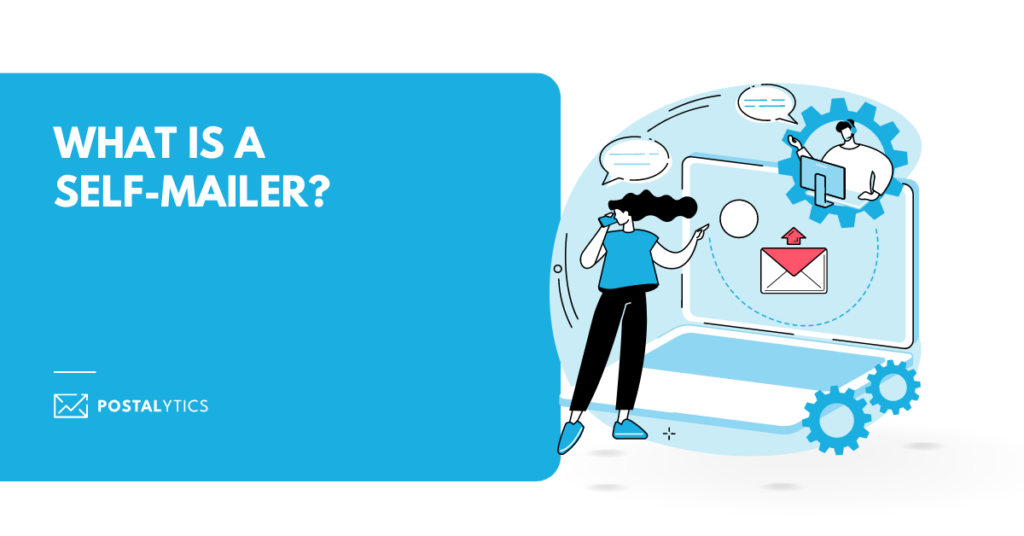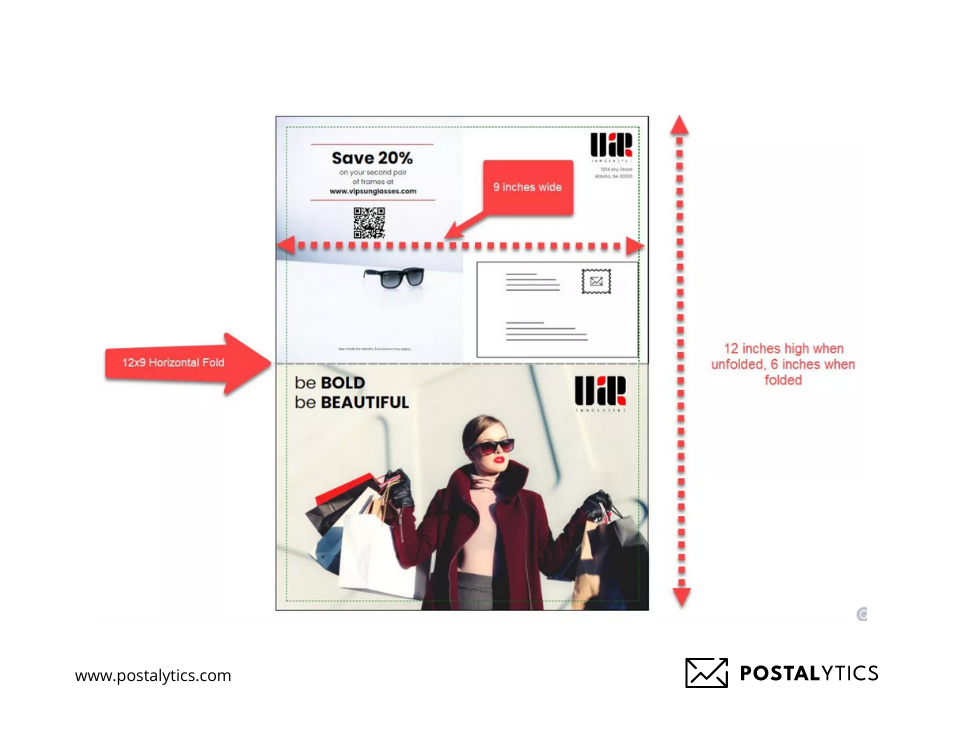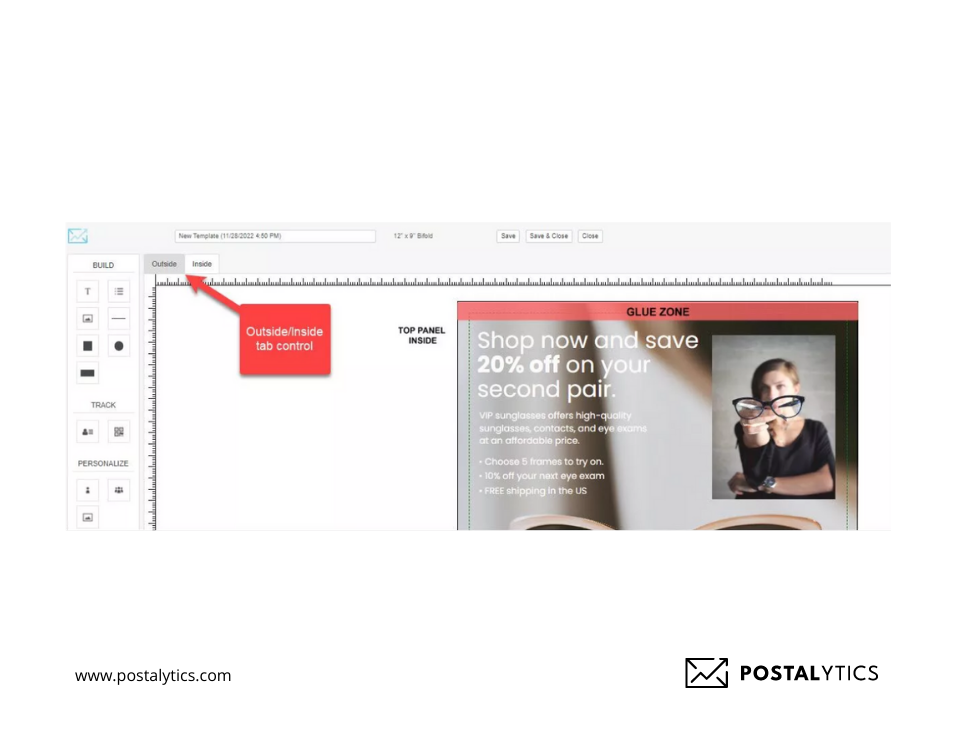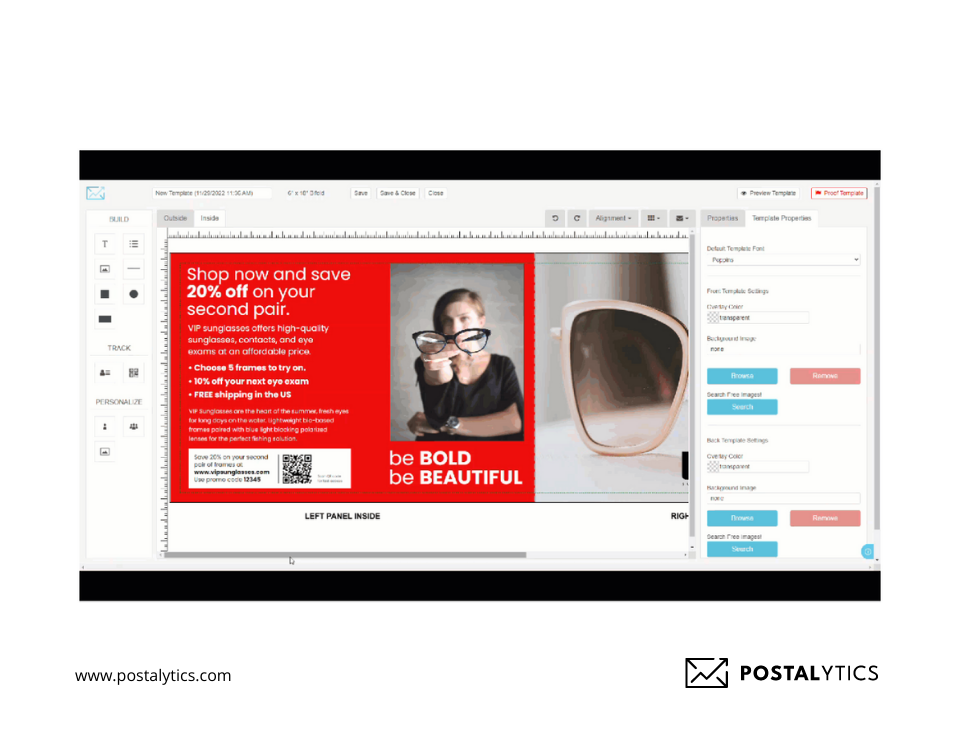
With many businesses now adopting direct mail marketing, new formats are being created almost daily as the competition drives businesses to get creative with how they reach their audience.
But one format that has remained evergreen for many years is the self-mailer.
A self-mailer refers to any promotional printed material sent without an envelope. These mailers are folded into panels and secured with glue or adhesive tabs so they don’t get opened or damaged during transit, and the address and postage are printed directly on the mail.
As a direct mail automation platform that provides self-mailer templates and automation, we have seen businesses utilize this format because of its many advantages. Let’s dive into the different self-mailer types and how to use them for your campaigns.
What We’ll Cover:
Exploring Your Options: Letter vs. Self-Mailer
The decision to send a letter or a self-mailer is one of the pressing questions many marketers face while choosing a direct mail format.
Let’s understand the pros and cons of each first.
Letter
A classic sales letter is generally more detailed and complex than a self-mailer. As a result, it is more costly and is used to build long-term relationships with customers and prospects.
Pros:
- It gives you more opportunities for personalization which makes the direct mail piece more interactive and engaging.
- The format allows you to include multiple inserts or collateral. You can even provide detailed information about your product or brand.
- The format is familiar to customers.
Cons:
- It is a costlier option.
- As many brands use this format, your letter can get lost in a sea of other letters.
- It’s relatively long and more descriptive, so your audience may not be inclined to go through the entire content or even skim it.
Self-Mailer
As we already know the basics of self-mailers, let’s jump to the pros and cons.
Pros:
- These mailers are visually more engaging and catch the attention of your audience.
- It isn’t full of content, so people can easily skim everything and act on your CTA.
- It is a cost-effective option so small businesses can utilize them for their campaigns.
Cons:
- It has limited space, so the format doesn’t work well for lengthy messages or detailed information.
- This mail is generally graphic-heavy, so your main message may get less attention.
So, which format should you use?
The answer, of course, depends on what outcomes you want to achieve.
For example, a letter may be your best bet if you want to develop a more personal relationship with your target customers. On the other hand, if you want to promote an event or share a coupon code, self-mailers can be a more suitable format choice as they can easily be shared and are more affordable.
Types of Self-Mailers
There are five different types of self-mailers you can use depending on your campaign goals. Let’s go through each in detail, highlighting the best use case for each.
Folded
As the name suggests, a folded self-mailer involves folded paper with a sealed edge. It is one of the most commonly used self-mailers, and it comes in three popular variations:
- Tri-fold self-mailer: This measures around 6’’ x 11’’ when you fold it. It can be used for product catalogs, real estate brochures or to include coupons using a perforated inline.
- 4-panel self-mailer: This is smaller than a tri-fold self-mailer and is generally used for short campaigns with a singular objective. Stunning visuals and graphics often support the primary message in the mailer. It works well in horizontal and vertical formats.
- 6-panel self-mailer: This is the largest option among self-mailers and is popularly used for newsletters and other long content pieces. It provides eight individual panels with huge space for all your content.
This option is best for businesses that want to convey more information without significantly increasing the mail size. You can keep adding more content or data by increasing the number of folds.
Bi-fold
Bi-folded self-mailers have a single fold and an adhesive or fastener that holds the fold together while in transit. These self-mailers come in two sizes to help teams come up with many creative styles:
- 12 x 9 bi-fold self-mailer: The location of the fold is the main differentiating factor between these two mailers. The 12 x 9 format has a horizontal fold, opening vertically.

The Outside/Inside tab control in Postalytics allows you to edit these panels of your self-mailers quickly.

- 6 x 18 Bi-fold self-mailer: This mailer has a vertical fold that enables it to open horizontally, creating a wide canvas for your inside panel. The Postalytics editor helps you easily slide left and right to edit or create these pieces.

Postcard
A self-mailer postcard offers limited space to show your creativity, but it’s still a powerful direct mail format.
Because of its space limitations, an ideal use case for postcards would be campaigns that don’t require much content, like a thank you note or a coupon code campaign.
Many industries like real estate, healthcare, ecommerce, or SaaS can use this format when devising campaigns that aren’t too data-heavy or visually intensive—for example, sending a postcard with a house listing and a short promotional message.
Booklet
A self-mailer booklet is smaller than a book, usually containing anywhere between 4 to 40 pages. This means you can provide a lot of information while using this format.
The size ranges from 5.5 x 8.5 to 12 x 12.
Here are four major uses for booklets:
- Newsletter booklets: Newsletters are a great way to keep your audience engaged by providing niche-related information.
- Brochure booklets: These typically contain information about your products (descriptions and pictures of your products)
- Instruction manuals: We have all received manuals with gadgets or complex products. It gives instructions on how to assemble, dismantle, or use the product.
- Reference guides: These are similar to instructional manuals but significantly short. Thus, it’s a good option when you want to highlight just the important bits like do’s and don’ts.
Catalog
Catalog self-mailers allow you to present your target customers with extensive information on your product range. These catalogs can be used like brochure booklets, and you can be as creative as you wish.
With the advent of QR codes, you can use them on your catalogs to bring your customers directly onto the product page and increase sales.
Postalytics offers an easy way to create and combine these QR codes with your direct mailing initiatives.

Advantages of Self-Mailers
With so many creative formats available with self-mailers, here are six benefits of using them.
Creative freedom
As self-mailers don’t have envelopes, you must be creative with your designs to attract more people and get them to act on your CTA. This means you have complete creative freedom to use attention-grabbing text and images.
When it comes to design, you can experiment with many elements like visuals, font styles, background themes, placements, etc.
This design freedom is why self-mailers are so popular when promoting events, upcoming sales, or marketing your products and services with compelling descriptions.
Budget-friendly
One of the main reasons businesses pick self-mailers is because of their cost-saving potential. They can be less expensive to print as there’s generally just one piece of paper and no need for envelopes. You can even save overheads like money on paper costs.
You also don’t have to spend labor charges on having someone stuff the mailpiece into the envelope and check whether the address matches the one on the direct mailer. This can also help you automate
You can even save on postage rates if you send postcards to people in a service area using the USPS’s EDDM service.
Mass marketing
When it comes to mass marketing, self-mailers can be a great way to share your marketing message with a wider audience. It makes a strong visual impact on your target audience and leaves a lasting impression.
For example, you have sent a mailpiece to someone’s office. The person getting it will be immediately notified of the marketing message since there’s no envelope. If this mailpiece is further kept in the open, more people passing by will notice it too.
This helps you achieve a mass marketing appeal as more people than you intended often see the message.
Automation capability
Do you need to spend a lot of time working on your direct mail campaigns?
With a cost-effective marketing tool like Postalytics, you can access self-mail automation capabilities that help you save time, money, and energy.
For example, instead of creating mailing lists from scratch or entering all the details manually, Postalytics provides integrations with CRM and sales tools so you can directly import mailing lists and other relevant details for your campaigns.
You can even automate the deployment of your direct mail pieces instead of manually doing it at your end. These automation capabilities can help you reduce the turnaround time of your campaigns.
Event triggers and invitation
Have you ever stuck a coupon or an event invitation on your board or fridge so you don’t forget them?
Self-mailers can be a wonderful way to help your customers remember your upcoming event or sale. The visuals and bold graphics you use in these mailers can be the perfect event triggers and invitations.
It can also help you spread the word about your event by letting more people notice it whenever they glimpse your direct mail piece.
Pro-tip: Use appealing colors and fonts to get more attention for these event invites and announcements
Product offers and notifications
One way to increase response rates and conversions on your direct mail campaigns is by targeting those loyal customers associated with your brand and demonstrating interest in product offers and notifications.
You can create pop-ups on your website where people interested in these notifications can subscribe to your list. You can then nurture them and create direct mail campaigns for this audience.
Final Thoughts
As self-mailers have become easier to create and deploy, many businesses have devised innovative ways to use them for multiple purposes.
But to reap the benefits of this direct mail format, you need to use automation capabilities that will help save time and money.
Postalytics is a direct mail automation platform that provides all the features and functionalities you need to create these self-mailers easily and even track the responses of all your campaigns over time.
Get started with your free trial today.
About the Author

Dennis Kelly
Dennis Kelly is CEO and co-founder of Postalytics. Dennis joined Boingnet, the predecessor to Postalytics, in 2013. Boingnet was focused on providing print and direct mail marketing service providers the ability to add digital marketing channels to their direct mail campaigns. Postalytics is Dennis’ 6th startup. He has been involved in starting and growing early-stage technology ventures for over 30 years and has held senior management roles at a diverse set of large technology firms including Computer Associates, Palm Inc. and Achieve Healthcare Information Systems.
